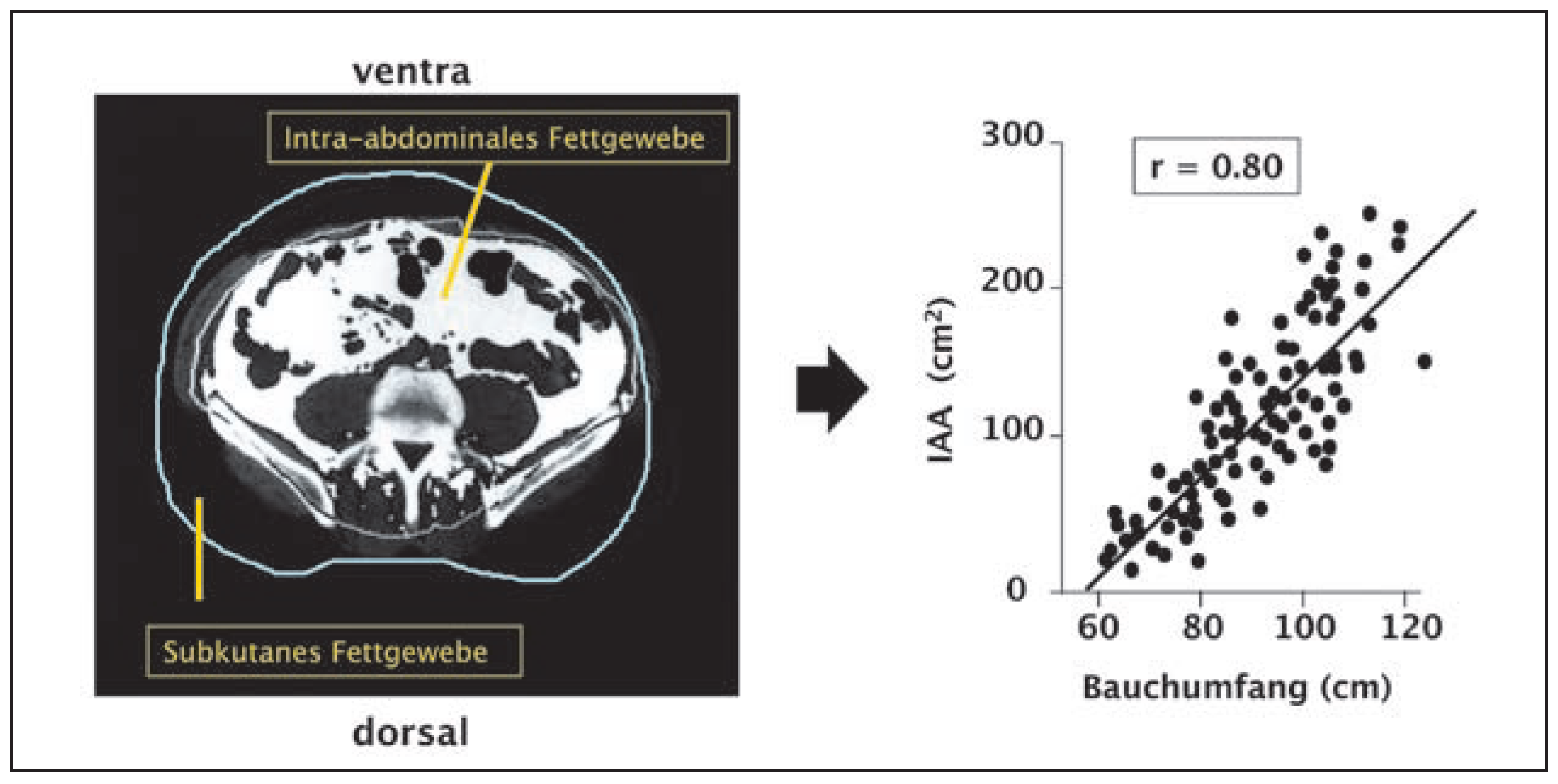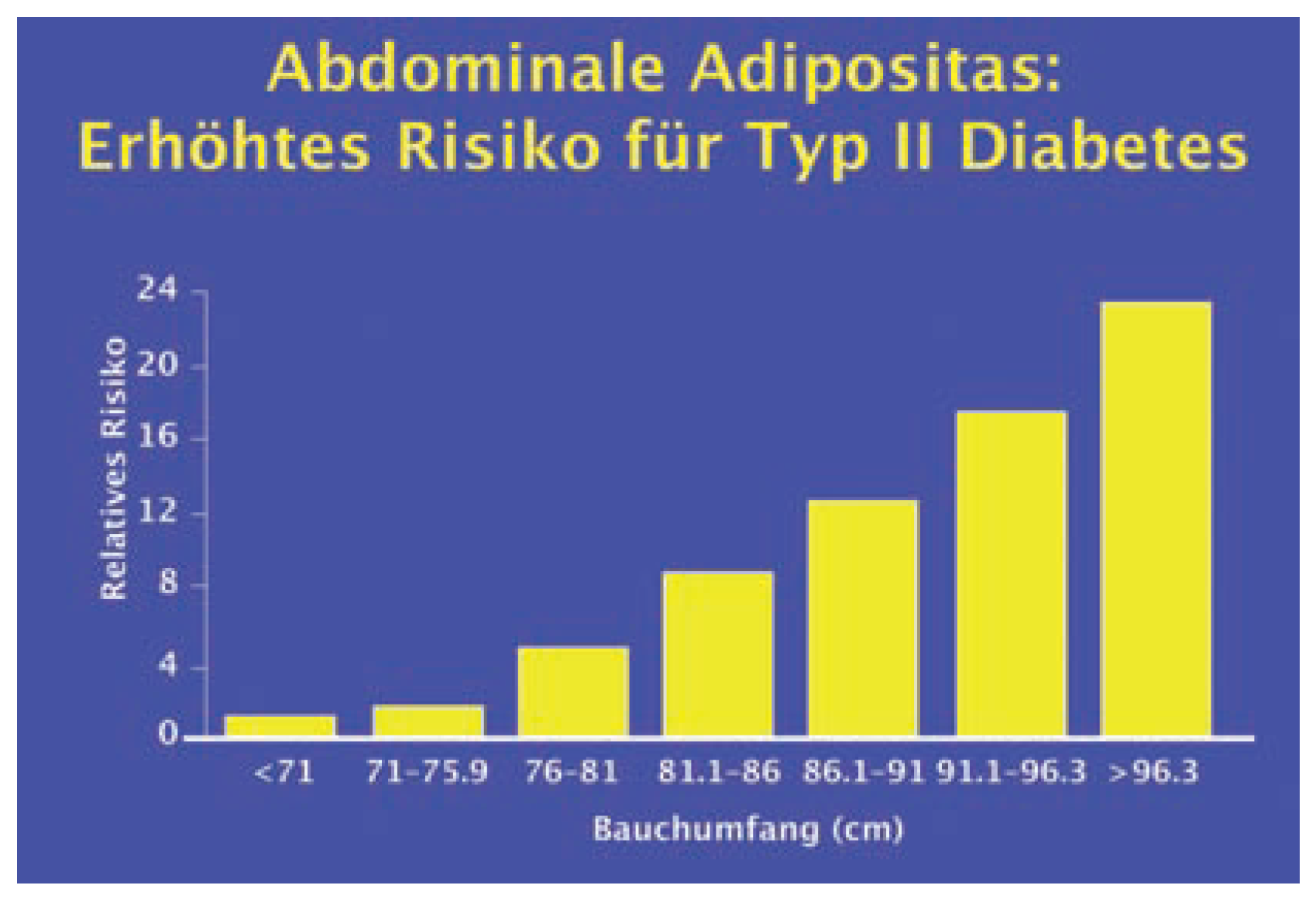Adipozyten: Endokrine Hochleistungsfabriken
Abstract
Zusammenfassung
Einführung
Das Fettgewebe als endokrines Organ
Abdominale Fettverteilung zeigt deutlich höhere Morbidität und Mortalität
Adipokine und Atherothrombose
Adipokine und Inflammation
Adipokine und Diabetes mellitus Typ 2
References
- Zhang, Y.; et al. Positional cloning of the mouse obese gene and its human homologue. Nature. 1994, 372, 425–432. [Google Scholar] [CrossRef] [PubMed]
- Campfield, L.A.; et al. Recombinant mouse OB protein: Evidence for a peripheral signal linking adiposity and central neuronal networks. Science. 1995, 269, 546–549. [Google Scholar] [CrossRef]
- Flier, J.S. The adipocyte: Storage depot or node on the energy information superhighway? Cell. 1995, 80, 15–18. [Google Scholar] [CrossRef]
- Ahima, R.S.; Flier, J.S. Adipose tissue as an endocrine organ. Trends Endocrino Metab. 2000, 11, 327–332. [Google Scholar] [CrossRef] [PubMed]
- Pouliot, M.C.; et al. Waist circumference and abdominal sagittal diameter: Best simple anthropometric indexes of abdominal visceral adipose tissue accumulation and related cardiovascular risk in men and women. Am J Cardiol. 1994, 73, 460–468. [Google Scholar] [CrossRef]
- Alessi, M.C.; et al. Plasminogen activator inhibitor 1, transforming growth factor-beta 1, and BMI are closely associated in human adipose tissue during morbid obesity. Diabetes. 2000, 49, 1374–1380. [Google Scholar] [CrossRef]
- Alessi, M.C.; et al. Production of plasminogen activator inhibitor 1 by human adipose tissue: Possible link between visceral fat accumulation and vascular disease. Diabetes. 1997, 46, 860–867. [Google Scholar] [CrossRef]
- Birgel, M.; et al. Role of cytokines in the regulation of plasminogen activator inhibitor-1 expression and secretion in newly differentiated subcutaneous human adipocytes. Arterioscler Thromb Vasc Biol. 2000, 20, 1682–1687. [Google Scholar] [CrossRef]
- Halleux, C.M.; et al. Hormonal control of plasminogen activator inhibitor-1 expression and production in human adipose tissue: Stimulation by glucocorticoïds and inhibition by catecholamines. J Clin Endocrinol Metab. 1999, 84, 4097–4105. [Google Scholar]
- Skurk, T.; et al. Effect of angiotensin peptides on PAI-1 expression and production in human adipocytes. Horm Metab Res. 2001, 33, 196–200. [Google Scholar] [CrossRef] [PubMed]
- Karlsson, C.; et al. Human adipose tissue express angiotensinogen and enzymes required for its conversion to angiotensin II. J Clin Endocrinol Metab. 1988, 83, 3925–3929. [Google Scholar]
- Engeli, S.; et al. Physiology and pathophysiology of the adipose tissue rennin-angiotensin system. Hypertension. 2000, 35, 1270–1277. [Google Scholar] [CrossRef]
- Ailhaud, G. Autocrine/paracrine effectors of adipogenesis. Ann Endocrinol. 2002, 63, 83–85. [Google Scholar]
- Massiera, M.; et al. Adipose angiotensinogen is involved in adipose tissue growth and blood pressure regulation. FASEB J. 2001, 15, 2727–2729. [Google Scholar] [CrossRef] [PubMed]
- Ailhaud, G. Cross talk between adipocytes and their precursors: Relationship with adipose tissue development and blood pressure. Ann NY Acad Sci. 1999, 892, 127–133. [Google Scholar] [CrossRef]
- Gottschling-Zeller, H.; et al. Troglitazone reduces plasminogen activator inhibitor-1 expression and secretion in cultured human adipocytes. Diabetologia. 2000, 43, 377–383. [Google Scholar] [CrossRef]
- Harte, A.L.; et al. Rosiglitazone inhibits the insulin-mediated increase in PAI-1 secretion in human abdominal subcutaneous adipocytes. Diabetes Obes Metab. 2003, 5, 302–310. [Google Scholar] [CrossRef] [PubMed]
- Marette, A.; et al. Mediators of cytokine-induced insulin resistance in obesity and other inflammatory settings. Curr Opin Clin Nutr Metab Care. 2002, 5, 377–383. [Google Scholar] [CrossRef]
- Hotamisligil, G.S. Inflammatory pathways and Insulin action. Int J Obes Relat Metab Disord. 2003, 27 (Suppl 3), S53–5. [Google Scholar] [CrossRef] [PubMed]
- Weisberg, S.; et al. Obesity is assosciated with macrophage accumulation in adipose tissue. J Clin Invest. 2003, 112, 1796–1808. [Google Scholar] [CrossRef]
- Grundy, S.M. Drug therapy of the metabolic syndrome: Minimizing the emerging crisis in polypharmacy. Nat Rev Drug Discov. 2006, 5, 295–309. [Google Scholar] [CrossRef]
- Scherer, P.E.; et al. A novel serum protein similar to C1q. produced exclusively in adipocytes. J Biol Chem. 1995, 270, 26746–26749. [Google Scholar] [CrossRef]
- Yamuchi, T.; et al. The fat derived hormone adiponectin reverses insulin resistance associated with both lipodystrophy and obesity. Nature Med. 2001, 7, 941–946. [Google Scholar] [CrossRef]
- Freubis, J.; et al. Proteolytic cleavage product of 30-kDa adipocyte complement-related protein increases fatty acid oxidation in muscle and causes weight loss in mice. Proc Natl Acad Sci USA. 2001, 98, 2005–2010. [Google Scholar] [CrossRef] [PubMed]
- Yang, W.S.; et al. Weight reduction increases plasma levels of an adipose-derived anti-inflamatory protein, adiponectin. J Clin Endocrinol Metab. 2001, 86, 3815–3819. [Google Scholar] [CrossRef]
- Schulze, M.B.; et al. Realtionship between Adiponectin and Glycemic Control, Blood Lipids, and Inflammation in Diabetes. Diabetes Care. 2004, 27, 1680–1687. [Google Scholar] [CrossRef]
- Bensaid, M.; et al. The cannabinoid CB1 receptor antagonist SR141716 increases Acrp30 mRNA expression in adipose tissue of obese fa/fa rats and in cultured adipocyte cells. Mol Pharmacol. 2003, 63, 908–914. [Google Scholar] [CrossRef]
- Kawanami, D.; et al. Direct reciprocal effects of resistin and Adiponectin on vascular endothelial cells: A new insight into adipocytokine-endothelial cell interactions. Biochem Biophys Res Commun. 2004, 6, 415–419. [Google Scholar] [CrossRef] [PubMed]
- Chen, M.P.; et al. Elevated Plasma Level of Visfatin/Pre-B Cell Colony-Enhancing Factor in Patients with Type 2 Diabetes mellitus. J Clin Endocrinol Metab. 2006, 91, 255–259. [Google Scholar] [CrossRef] [PubMed]
- Takashi, K.; Toshimasa, Y. Adiponectin and Adiponectin Receptors. Endocrine Reviews. 2005, 26, 439–451. [Google Scholar]
- Carey, V.J. Body fat distribution and risk of non-insulindependent diabetes mellitus in women. The Nurses’ Health Study. Am J Epidemiol. 1997, 145, 614–619. [Google Scholar] [CrossRef]
- Fasshauer, M.; et al. Hormonal regulation of adiponectin gene expression in 3T3-L1 adipocytes. Biochem Biophys Res Commun. 2002, 290, 1084–1089. [Google Scholar] [CrossRef]
- Halleux, C.M.; et al. Secretion of adiponectin and regulation of apM1 gene expression in human visceral adipose tissue. Biochem Biophys Res Commun. 2001, 288, 1102–1107. [Google Scholar] [CrossRef] [PubMed]
- Maeda, N.; et al. PPARgamma ligands increase expression and plasma concentrations of adiponectin, an adipose-derived protein. Diabetes. 2001, 50, 2094–2099. [Google Scholar] [CrossRef] [PubMed]
- Roberts, A.W.; et al. Peroxisome proliferators.activated receptor-gamma agonists in atherosclerosis: Current evidence and future directions. Curr Opin Lipidol. 2003, 14, 567–573. [Google Scholar] [CrossRef]
- Masuzaki, H.; et al. Atransgenic model of visceral obesity and the metabolic syndrome. Science. 2001, 294, 2166–2171. [Google Scholar] [CrossRef] [PubMed]
- Bujalska, I.J.; et al. 11b-hydroxysteroid dehydrogenase type 1-knockout mice show attenuated glucocorticoïd-inducible responses and resist hyperglycemia on obesity or stress. Proc Natl Acad Sci USA. 1997, 94, 14924–14929. [Google Scholar]
- Berger, J.; et al. Peroxisome proliferator-activated receptor-g ligands inhibit adipocyte 11b-hydroxysteroid dehydrogenase type 1 expression and activity. J Biol Chem. 2001, 276, 12629–12635. [Google Scholar] [CrossRef]





© 2007 by the author. Attribution—Non-Commercial—NoDerivatives 4.0.
Share and Cite
Gaillard, R.C. Adipozyten: Endokrine Hochleistungsfabriken. Cardiovasc. Med. 2007, 10, 163. https://doi.org/10.4414/cvm.2007.01248
Gaillard RC. Adipozyten: Endokrine Hochleistungsfabriken. Cardiovascular Medicine. 2007; 10(5):163. https://doi.org/10.4414/cvm.2007.01248
Chicago/Turabian StyleGaillard, Rolf Christian. 2007. "Adipozyten: Endokrine Hochleistungsfabriken" Cardiovascular Medicine 10, no. 5: 163. https://doi.org/10.4414/cvm.2007.01248
APA StyleGaillard, R. C. (2007). Adipozyten: Endokrine Hochleistungsfabriken. Cardiovascular Medicine, 10(5), 163. https://doi.org/10.4414/cvm.2007.01248



